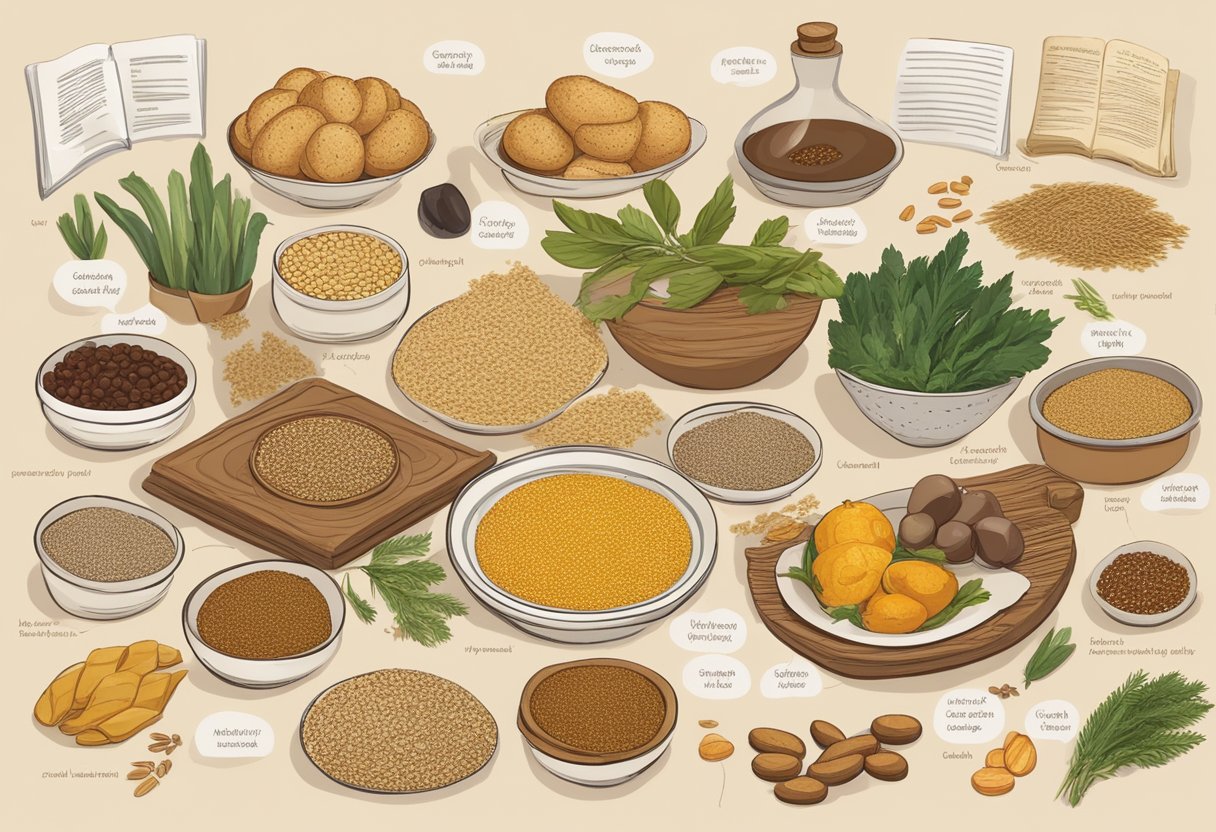The concept of gluten-free eating has its roots deeply entrenched in the past, and the Mediterranean region, with its rich history and diverse food culture, provides a unique lens to examine this diet’s evolution. It was during the food scarcity of World War II that the benefits of a gluten-free diet came into prominence, particularly for children suffering from malnourishment and celiac disease. This discovery led to the identification of gluten as the aggravating factor in celiac disease, thus laying the foundation for gluten-free dietary practices.

With the establishment of the benefits of a gluten-free diet for those with celiac disease, the diet gained traction in the medical community. Beyond medical necessity, the diet has found a broader appeal in the modern world, with many adopting it for perceived health benefits and lifestyle choices. The intersection of traditional Mediterranean diets and gluten-free eating showcases a harmonious blend of nutritional well-being and culinary richness. Through the years, the gluten-free diet has evolved from a medical prescription to a mainstream trend, influencing food production, market growth, and societal habits.
Key Takeaways
- The Mediterranean has been pivotal in the historical development of gluten-free diets.
- Gluten-free eating intertwines with medical findings and cultural dietary practices.
- The evolution of the gluten-free diet reflects broader societal and market changes.
The Rise of Gluten-Free in Historical Context

Tracing the roots of gluten-free eating in the Mediterranean sheds light on the evolution of dietary practices from ancient grain consumption to the medical research that has shaped today’s gluten-free diets.
Origins of Gluten Consumption in the Mediterranean
In the Mediterranean basin, the cultivation and consumption of gluten-containing grains like wheat, rye, and barley have been integral to the diet for thousands of years. The three grains were the bedrock of Mediterranean cuisine, acting as crucial staples long before the concept of gluten and its associated effects were understood.
The Industrial Revolution and Processed Foods
The Industrial Revolution marked a period of significant change in the availability of these grains. With advancements in technology, the production of baked goods was transformed, increasing the consumption of gluten-rich foods. New methods of cultivation and processing caused these staple grains to become ubiquitous in Western diets, extending their reach far beyond the confines of the Mediterranean.
Historical Figures in Gluten-Free Research
A pivotal person in the history of gluten-free research was Willem-Karel Dicke, a Dutch physician who made groundbreaking connections between celiac disease and the ingestion of gluten during the mid-20th century. Dicke’s research highlighted the importance of a gluten-free diet in the management of celiac disease, setting the stage for contemporary understanding and practices.
World War II and Gluten-Free Discoveries
During World War II, shortages of wheat led to improvised diets. This time of scarcity unwittingly facilitated observations that children with celiac disease improved when bread was less available. Post-war investigations confirmed the connection, solidifying the importance of a gluten-free diet for those suffering from the autoimmune disorder and establishing a new dietary need that echoed beyond the Mediterranean region.
Medical Understanding of Gluten-Related Disorders

The medical community recognizes gluten-related disorders as a spectrum, ranging from autoimmune responses, such as celiac disease, to non-autoimmune sensitivities like non-celiac gluten sensitivity. These conditions, which often present with overlapping symptoms, have spurred significant advances in diagnostic approaches and a deeper understanding of their etiologies.
Identification of Celiac Disease
Celiac disease is an autoimmune disorder where ingestion of gluten leads to damage in the small intestine, specifically causing villous atrophy. It is triggered in genetically predisposed individuals carrying the HLA-DQ2 or HLA-DQ8 genes. Diarrhea, weight loss, and malnutrition are common symptoms, though the presentation can vary greatly.
Non-Celiac Gluten Sensitivity and Related Conditions
Non-celiac gluten sensitivity (NCGS) presents symptoms similar to celiac disease, including intestinal permeability and irritable bowel syndrome, but does not involve the autoimmune mediated villous atrophy. Gluten sensitivity is currently identified through a process of exclusion as there are no definitive biomarkers. Related conditions also include gluten ataxia and dermatitis herpetiformis.
Advancements in Gluten Intolerance Diagnosis
The diagnosis of gluten-related disorders has evolved with the development of serological tests such as tissue transglutaminase (tTG) antibodies used for celiac disease. An increased understanding of immunological disorders tied to gluten, like wheat allergy and its distinction from celiac disease, has also improved diagnosis.
Autoimmune Diseases and Gluten
Celiac disease is but one autoimmune disease linked to gluten; others include type 1 diabetes. Gluten intake in susceptible individuals can exacerbate these conditions, highlighting the importance of a gluten-free diet as a therapeutic intervention for managing symptoms and preventing long-term complications of chronic disease.
Nutrition and Health Implications of a Gluten-Free Diet

Adopting a gluten-free diet can lead to significant changes in nutrient intake. This section examines both the benefits and the potential concerns regarding the nutritional aspects of a gluten-free lifestyle.
Nutrients and Fiber in Gluten-Free Grains
Gluten-free grains like quinoa and buckwheat are praised for their nutrient profiles. They provide essential micronutrients such as iron and zinc, and other B vitamins. However, they might not offer the same fiber content as their gluten-containing counterparts, which is essential for digestive health.
Weight Management and Gluten-Free Lifestyle
Individuals on a gluten-free diet may notice a change in weight as they swap out traditional carbohydrate sources for other foods. It is critical to focus on balanced meals with a variety of gluten-free grains, proteins, and fats to maintain a healthy weight.
Potential Health Risks and Nutritional Deficiencies
A gluten-free diet can lead to deficiencies in certain nutrients if not carefully managed. Essential nutrients often lacking include fiber, calcium, vitamin D, vitamin B12, and folic acid. Subscribers to this diet should be aware of these potential risks and plan their meals accordingly to prevent malnutrition.
Dietary Supplementation and Gluten-Free Eating
In some instances, dietary supplements may be necessary to meet the nutritional requirements on a gluten-free diet. Supplements can help prevent deficiencies in vitamin D, calcium, and B vitamins. It’s important to choose supplements carefully to avoid any that may contain gluten as a hidden ingredient.
Gluten-Free Food Production and Market Growth

The roots of gluten-free eating trace back centuries, yet recent advancements in food production and market trends have significantly shaped contemporary gluten-free offerings. Key developments include the evolution of gluten-free bread and pasta, which hinge on the needs of those with celiac disease and the broader market embracing wheat-free diets.
Evolution of Gluten-Free Products
The production of gluten-free products has transformed from basic rice and potato-based alternatives to a sophisticated range that incorporates pseudocereals like quinoa and millet. Innovations in food technology have allowed manufacturers to substitute the gluten proteins—gliadin and glutenin—found in traditional wheat products with other protein sources, enhancing both texture and taste.
Trends in Gluten-Free Bread and Pasta
Gluten-free bread and pasta have undergone significant refinement. Initially characterized by a lack of flavor and desirable texture, recent iterations employ blends of whole grains and pseudocereals to rival their wheat-based counterparts. Food manufacturers have responded to demands for healthier options that don’t rely on simple carbohydrates, instead offering products higher in nutrients and protein.
Gluten-Free Market Analysis
The gluten-free market has witnessed substantial growth, with the sector expanding in response to increased awareness of celiac disease and a general trend towards wheat-free diets. Bread and pasta represent key categories driving this growth, as consumers look for gluten-free alternatives to staple foods.
Global Influence on Gluten-Free Consumption
The popularity of the Mediterranean diet and its reliance on grains like buckwheat and rice has inspired a global shift in gluten-free consumption patterns. With rising prevalence of celiac disease and lifestyle choices steering away from traditional wheat products, there has been an international rise in demand for gluten-free options, influencing market growth.
Societal and Lifestyle Impacts of Gluten-Free Diets

The evolution of gluten-free eating has not only changed dietary habits but also significantly influenced public awareness and social dynamics. These changes bring to the fore issues such as cross-contamination and the responsibilities of healthcare providers to facilitate optimal patient care for those with gluten sensitivities.
Public Awareness and Perception of Gluten-Free
In recent years, there has been a surge in public awareness regarding gluten-free diets. Originally a treatment for celiac disease, the gluten-free diet has now permeated the general population, often linked with weight loss and healthful eating. Physicians and nutritionists now find themselves navigating an expanded pool of individuals opting for gluten-free choices, some not out of necessity but rather personal preference. These societal shifts have also influenced the availability of gluten-free products in markets traditionally dominated by staple foods containing gluten.
The Impact of Gluten-Free Eating on Social Dynamics
The expansion of gluten-free eating preferences has intricately woven itself into the social fabric. Dining out or sharing meals, once a straightforward activity, now often involves a detailed discourse on dietary needs. Restaurants and foodservice providers are increasingly aware of these requirements, with dedicated menus and preparation areas to avoid cross-contamination concerns. This demonstrates an increased commitment to accommodate diverse dietary restrictions, enhancing social dynamics and interactions.
Cross-Contamination Concerns for Gluten-Sensitive Individuals
For individuals with celiac disease or non-celiac gluten sensitivity, the fear of cross-contamination is a pressing concern. It necessitates vigilance in environments where gluten-containing foods are present. Healthcare providers bear the responsibility of educating patients about safeguarding their diets to avoid accidental ingestion, which can lead to serious health repercussions. Clear communication about these risks and the importance of strict adherence to a gluten-free diet is essential for optimal patient care.
Scientific and Clinical Perspectives

The scientific and clinical exploration of gluten-free eating in the Mediterranean sheds light on the gastrointestinal, genetic, and dietary guideline innovations that have developed over time.
Research on Gastrointestinal Impact and Gluten
Gastrointestinal symptoms such as constipation, bloating, abdominal pain, and severe diarrhea are often associated with gluten ingestion in sensitive individuals. Scientists have studied the small intestine’s permeability and reactions to gluten, observing conditions like villous atrophy, where the nutrient-absorbing finger-like projections of the small bowel mucosa are damaged. This damage is seen in celiac disease, an autoimmune condition that impairs digestion and leads to malabsorption.
The Role of Genetics and Environment in Gluten Sensitivity
Research indicates a strong genetic component in gluten-related disorders, where genes encoding HLA-DQ2 or HLA-DQ8 molecules predispose individuals to celiac disease. However, environmental factors also play a significant role. For instance, the timing of gluten introduction and the amount of gluten consumed can influence the development of gluten sensitivity. Studies also suggest that certain infections and changes in gut bacteria might affect gastrointestinal metabolism and inflammation, leading to an increased risk of gluten-related disorders.
Innovations in Gluten-Free Dietary Guidelines
Dietary guidelines for gluten-related disorders are continuously evolving as new scientific insights emerge. For pediatric patients and adults alike, a gluten-free diet is the primary treatment, requiring diligent avoidance of gluten-containing products to manage symptoms and promote intestinal healing. Innovations in dietary management have included advancements in gluten-free product availability and labelling, as well as protocols for monitoring tissue transglutaminase levels, an enzyme and autoantibody involved in celiac disease, to assess dietary adherence and mucosal recovery.
Frequently Asked Questions

In examining the gluten-free diet within Mediterranean cultures, one can trace historical practices that influence today’s eating habits. This section answers pertinent queries regarding the evolution, components, and nutritional value of a gluten-free Mediterranean diet, and its connection to celiac disease.
How has the gluten-free diet evolved over time in Mediterranean cultures?
Initially observed during World War II when some children with celiac disease showed improvement due to wheat shortages, the gluten-free diet has since become more sophisticated in Mediterranean regions. Today, it integrates local ingredients such as olives and legumes that naturally do not contain gluten.
What are the staple foods of a gluten-free Mediterranean diet?
A gluten-free Mediterranean diet relies on fruits, vegetables, nuts, seeds, legumes, fish, and meats, which are naturally gluten-free. Grains like rice and corn are also common, as well as alternatives such as quinoa and buckwheat.
What is the relationship between celiac disease and gluten-free eating in Mediterranean regions?
The prevalence of celiac disease has necessitated the availability of gluten-free options in the Mediterranean. Societal awareness and medical advancements have fostered a supportive environment for gluten-free eating to alleviate symptoms and prevent complications of the disease.
How do traditional Mediterranean diets accommodate gluten-free requirements?
Traditional Mediterranean diets naturally consist of gluten-free foods, such as legumes and olive oil. Adaptations include using gluten-free grains for pasta and bread or utilizing almond or chickpea flour for baking.
Can a gluten-free Mediterranean diet provide all essential nutrients?
Yes, a gluten-free Mediterranean diet can be nutritionally balanced. It emphasizes a variety of foods, rich in essential nutrients like fiber from fruits and vegetables, protein from legumes and fish, and healthy fats from olive oil and nuts.
What historical practices in Mediterranean cuisine have contributed to modern gluten-free eating habits?
Historical Mediterranean practices, such as the use of alternative grains and the high consumption of fresh produce, have laid the foundation for modern gluten-free diets. These practices have allowed for a seamless integration of gluten-free options into traditional dishes.



